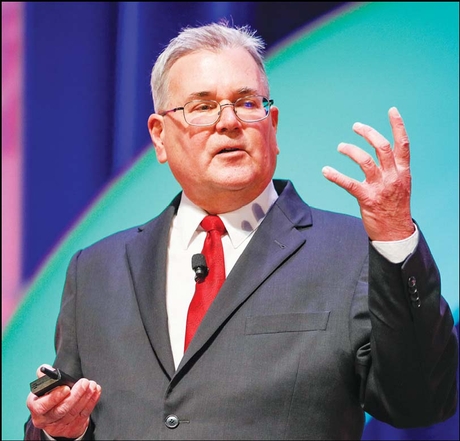While effective treatments for amyotrophic lateral sclerosis (ALS) remain frustratingly out of reach, recent advances hold promise for unlocking its mysteries, a leading expert said Monday.

Pascuzzi
"ALS is a horrible disease, but right now there is reason to be optimistic that we can turn things around," said Robert M. Pascuzzi, MD, professor of neurology at the Indiana University School of Medicine in Indianapolis and director of the ALS program at Indiana University Health, during his New Horizons lecture at the Arie Crown Theater. Radiology, he stressed, plays a critical role in the battle against ALS.
Dr. Pascuzzi described how Jean-Martin Charcot, a native of France who is considered the Father of Neurology, first reported the disease in 1874 as a progressive disease of the brain and spinal cord characterized by creeping paralysis and loss of function. Most patients live only two to five years after the appearance of symptoms. The cause is not known for the vast majority of patients.
The disease's rapid, relentless course has generated much public attention, perhaps never more so than in the case of Lou Gehrig, the legendary first baseman for the formidable New York Yankees of the 1920s and '30s.
Gehrig, so well-known for his durability that he was nicknamed "the Iron Horse," experienced a dramatic drop-off in his performance in the spring of 1939. Actions once routine for him, like fielding the ball or running the bases, became difficult. Dr. Pascuzzi described how, after Gehrig's diagnosis at the Mayo Clinic in Minnesota, he enrolled in a clinical trial looking at vitamin E as a possible treatment for the disease. The published study included a sanguine pronouncement on Gehrig's status: "The case may be regarded as definitely arrested and somewhat improved."
"What's interesting is that this publication came out almost to the week of Lou Gehrig's obituary being published," Dr. Pascuzzi said.
A Multifaceted Approach to ALS
Current clinical management of ALS involves treatment of symptoms with medications and physical therapy, along with devices like braces and wheelchairs to help patients function in their everyday lives.
There are two FDA-approved drugs that slow down the disease. Riluzole, a drug that inhibits the release of the neurotransmitter glutamate, prolongs survival by about two to three months. The antioxidant edaravone (Radicava) was approved by the FDA in 2017 based on a study in Japan that found it slowed progression of symptoms in about 30 percent of patients.
However, both treatments have only a mild impact on the disease, Dr. Pascuzzi said.
About 25 different treatments are currently being researched, Dr. Pascuzzi said. Stem cells can be delivered into the spinal canal, although Dr. Pascuzzi believes that such treatment is more likely to slow the disease down than cure it.
Curative investigations focus on C9, a gene that provides instructions for making a protein abundant in nerve cells. Mutations in C9 are the most common cause of familial forms of ALS. In healthy people, the sequence of nucleotides that makes up C9 is relatively short; in people with ALS, it is very long and cluttered with extraneous material.
"How's the poor cell supposed to read all this?" asked Dr. Pascuzzi, presenting a slide depicting line after line of genetic code. "You need to eliminate the clutter or the cells are going to fail."
One approach currently in clinical trials involves the use of antisense oligonucleotides, small pieces of genetic material that help suppress unwanted DNA from being read. These gene-suppressing fragments have been used successfully in spinal muscular atrophy, a formerly fatal neuron disease of childhood.
Dr. Pascuzzi, who was introduced by his sister, RSNA President Valerie P. Jackson, MD, emphasized that imaging will be central to any progress against the disease.
"Radiology serves an essential role, mainly to make sure that the neurologist isn't missing something else that we could treat better," he said. "We neurologists couldn't exist without what you guys do."
Related links:

